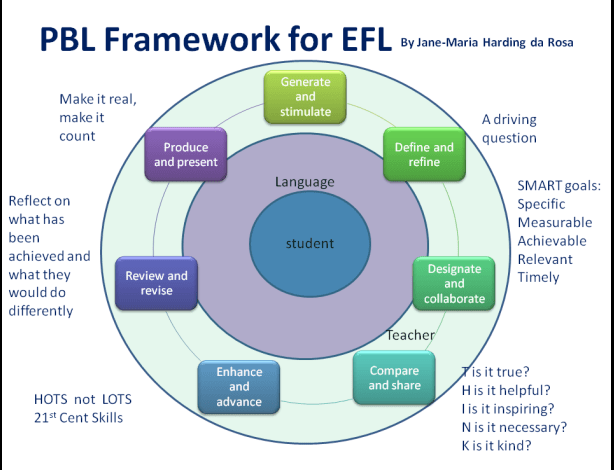All about PBL: How to Learn a Language through Projects
By Maria Conca
If you haven’t heard of PBL before, it’s the acronym that stands for Project Based Learning. If you think PBL is about doing a project at the end of your lesson, read on to find out about what PBL is or isn’t.
What is PBL exactly?
Project Based Learning is a pedagogic framework to learn and teach a subject through a project. It’s a ‘teaching method in which students gain knowledge and skills by working for an extended period of time to investigate and respond to an authentic, engaging, and complex question, problem, or challenge’ (Buck Institute for Education, 2018). Recently, a few ELT practitioners have come up with a framework to make PBL applicable to ELT while expanding on the principles and practice of task-based learning. The best example is the PBL framework below by Jane-Maria Harding Da Rosa from IH Newcastle (2018).

Source: https://oupeltglobalblog.com/tag/jane-maria-harding-da-rosa/ (2018)
The idea of task-based and project-based learning in ELT is not new. Project work is integrated into many ELT programmes and coursebooks nowadays. However, ‘doing a project’ does not always equal ‘learning through a project’.
How does PBL differ from ‘doing a project’?
‘Doing a project’ requires students to do a short project that usually has the objective to consolidate the content of a teaching unit. For example, imagine you have covered the present perfect in the context of life experiences with your teen class at B1 level; you want your students to practise the new language learnt; you would probably ask them to do a project, e.g. create a class survey about things they have or haven’t done, collect data and present the results.
In PBL instead, the project is the unit. It is the vehicle for learning and developing skills (Buck Institute of Education, 2018). The aim is to engage students in solving a real-world problem or answering a driving question, which requires
- an extended period of time
- meaningful language use
- use of life skills - communication & collaboration, creativity, critical thinking, problem solving (21st century skills – 4C)
When does language come into play? Anytime, at different stages of the project through students’ collaborative work and negotiations, access to authentic sources, and through teacher’s language input. Now, how do plan a PBL lesson? Let’s review key PBL principles first.
Principles of PBL in a nutshell
- Self-directed learning through student-led activities
- An extended project over an extended period of time
- A key driving question leading to an investigation and clear outcomes
- A high quality product (audio-visual/digital/physical) shared with an audience (live/virtual) as a tangible project outcome that demonstrates students’ knowledge and skills
- Core skills development: 21C skills; citizenship, intercultural competence, digital literacy (also developed through the CLIL 4C framework)
- Student Role: choice (investigation process & tools, sources, output mode, outcomes), self- & peer-evaluation, relevant feedback on own and others’ work to enhance results
- Teacher role: poses a driving question, stimulates discussion and creativity, sets goals, provides language input & corrective feedback, works as a facilitator at each stage
Planning a PBL lesson
Inspired by the PBL framework by Harding Da Rosa above and her call to make PBL ‘your own’, I have designed my own framework. Imagine you want to teach the present perfect in the context of life experiences to teens at B1 level. Here’s a sample PBL lesson outline:
| STAGE 1 Brainstorm & Define |
Driving question ‘Which things do you think teens should try before (going to university)?’ Brainstorm categories & ideas e.g. extremes sports, low-emissions travelling, learning Hindi or coding Define aspect Trying an unforgettable experience or Learning a new skill? |
| STAGE 2 Goal setting & Collaborate |
Use SMART mnemonics to suggest outcomes Present data to answer the driving question Designate & Collaborate to decide How to investigate - online poll, school/class survey, interviews, readings Sources of information - research existing data, collect new data How to present findings - infographics, video animation, article Output mode - oral/written, both Language input Questions ‘Have you ever...?’ ‘Have you tried …yet?’ ‘Why or Why not?’ Collaborate to reach goals Collect data/information Find most suitable way to present it |
| STAGE 3 Compare & Enhance |
Share & Evaluate project outcomes Teacher/groups use THINK mnemonics to give feedback Groups reflect on feedback & take it on board |
| STAGE 4 Review & Produce |
Review work Create products |
| STAGE 5 Present & Self-assess |
Present outcomes to a live/virtual audience Self-assess performance |
This is how I made PBL my own to work for me. How will you make it your own?
 |
Maria Conca is a Teacher, Teacher Trainer, Materials Writer and Curriculum Developer. She has taught English for 12 years in Italy and the UK. She took her CELTA at IH Rome in 2007 and completed her Delta at IH Newcastle and Distance Delta IH London in 2016. She reads extensively about ELT research and often experiments with new approaches in her class and materials. Her main interests are YLs, Teaching Listening & Speaking, Second Language Acquisition (SLA), CLIL, TBLT and PBL. She tweets at @MConca16. |
|
References: Buck Institute for Education https://www.pblworks.org/what-is-pbl . Accessed on 17/10/2019 Harding Da Rosa Jane-Maria, IH Newcastle, ‘Promoting Project-based Learning’ https://oupeltglobalblog.com/tag/jane-maria-harding-da-rosa/ . Accessed on 17/10/19 To find out more Buck Institute for Education – PBLworks website https://www.pblworks.org Association for Language Learning https://www.all-languages.org.uk/research-practice/language-futures/resources-2/project-based-learning/ |
